LOWER BEAK
We examined only two beaks of I. cordiformis from individuals of nearly identical size (86 and 87 mm ML). The following characters are taken from Clarke (1986). Means are used, when appropriate, for measurements.
- Pigmentation - Very dark.
- Pigmentation pattern - At 87 mm ML, wing unpigmented to level of jaw angle; only medial surface of shoulder padding pigmented; lateral wall nearly fully pigmented.
- (Wing length)/(visible rostral edge) (profile) - 2.3
- Height/baseline (profile) - 0.95
- (Length from rostral tip to wing tip projected on baseline)/baseline (profile) - 0.16
- (Hood length)/(crest length) (profile) - 0.51
- (Crest length)/baseline (profile) - 0.79
- (Rostral base)/(visible rostral edge) (profile) - 1.2
- (Hood length)/(visible rostral edge) (profile) - 1.16
- Rostral width ratio [LRL/(length between jaw angles)] - 1.66 and 2.20
- Wing angle (= visible jaw angle in profile) - Approximate right angle.
- Shape of rostral edge - Almost straight but with small convex hook.
- Rostrum (profile) - Broad taper to tip.
- Hood distance from crest - Well clear of crest.
- Crest - Nearly straight.
- Lateral wall notch - Nearly absent.
- Hood-wing - Broad.
- Hood notch - Very broad.
- Lateral walls to free corner - Broadly separated with increasing but low divergence from one another.
- Hood midline - Moderately curved.
- Hood surface without consistent, prominent longitudinal ridges or grooves.
- Wing fold - Low, rounded, does not obscure jaw angle in profile.
- Shoulder - Shoulder blades broad, edges project, edges very irregular.
- Shoulder groove - Absent.
- Jaw angle - Angle variable, without associated step or transparent strip.
- Jaw edge extension without step and with prominent angle point extending well past shoulder padding; jaw edge extension without clear strip between it and shoulder blade.
- Jaw edge in cross-section - Sharp.
- Crest in cross-section - Broad bit rather sharply angled in midline; lateral wall convex between lateral wall fold and midline of crest
- Lateral wall - Low, broad, lateral-wall fold, with broad groove on medial surface, extends to posterior edge of lateral wall.

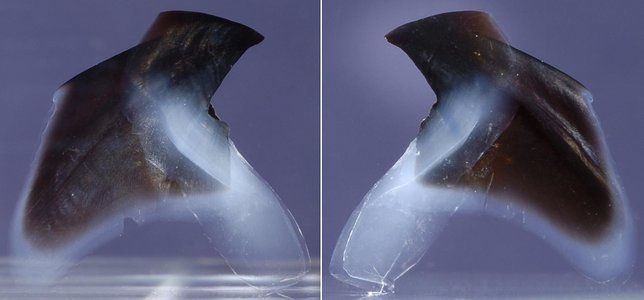
Figure. Left and right side views of the same lower beak of I. cordiformis, 86 mm ML, 2.8 mm LRL, immature female, 35°N, 139°E (off Japan). Photographs by R. Young.

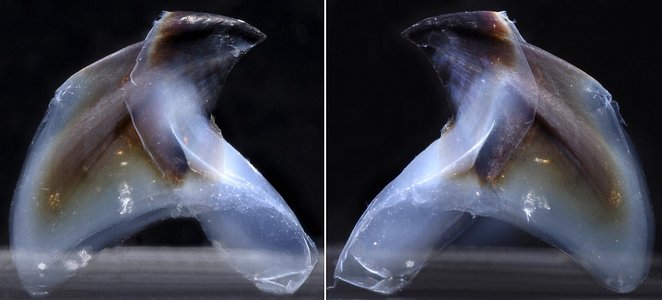
Figure. Left and right side views of the same lower beak of I. cordiformis, 87 mm ML, 2.6 mm LRL, immature female, 14°N, 121°E (off Philippines). Photographs by R. Young.

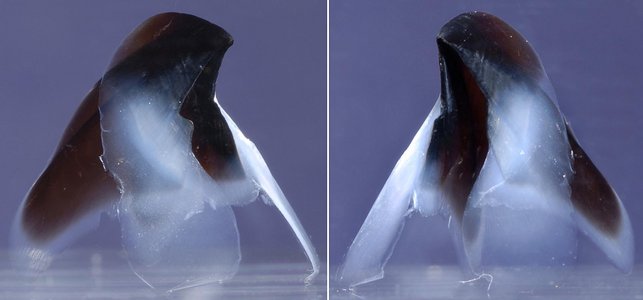
Figure. Left and right side-oblique views of the same lower beak of I. cordiformis, 86 mm ML, immature female, 35°N, 139°E (off Japan). Photographs by R. Young.

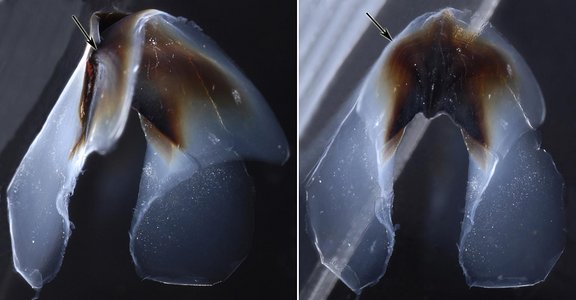
Figure. Posterior oblique (left) and posterior (right) views of the same lower beak of I. cordiformis 87 mm ML, immature female, 14°N, 121°E (off Philippines). Arrows point to the lateral wall fold. Photographs by R. Young.

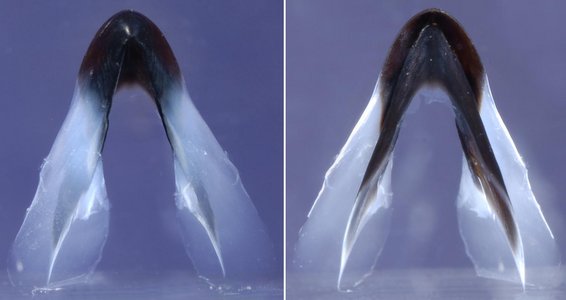
Figure. Front (left) and rear (right) views of the same lower beak of I. cordiformis, 86 mm ML, immature female, 35°N, 139°E (off Japan). Photographs by R. Young.

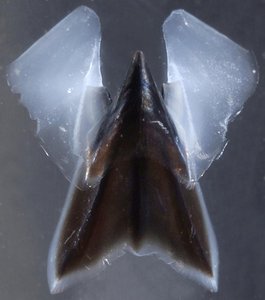
Figure. Top view of the lower beak of I. cordiformis, 86 mm ML, immature female, 35°N, 139°E (off Japan). Photograph by R. Young.
Comments
I. cordifromis lower beaks are easily separated from other broad-beaked mastigoteuthids (ie, Magnoteuthis species) by the height of the hood above the crest, the large size of the shoulder blade, the very dark pigmentation and the short wing to baseline ratio, among other features.
UPPER BEAK

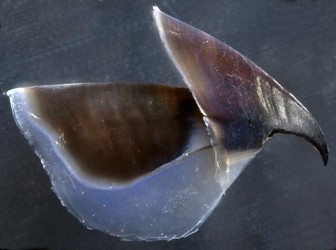
Figure. Side views of the lower beak of I. cordiformis, 86 mm ML, immature female, 35°N, 139°E (off Japan). Photographs by R. Young.

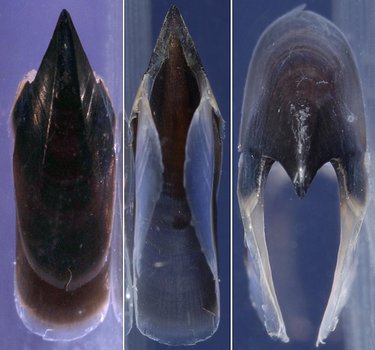
Figure. Various views of the upper beak of I. cordiformis, 86 mm ML, immature female, 35°N, 139°E (off Japan). Left - Top view. Middle - Bottom view. Right - Front view. Photographs by R. Young.
Comments
To be added.




 Go to quick links
Go to quick search
Go to navigation for this section of the ToL site
Go to detailed links for the ToL site
Go to quick links
Go to quick search
Go to navigation for this section of the ToL site
Go to detailed links for the ToL site